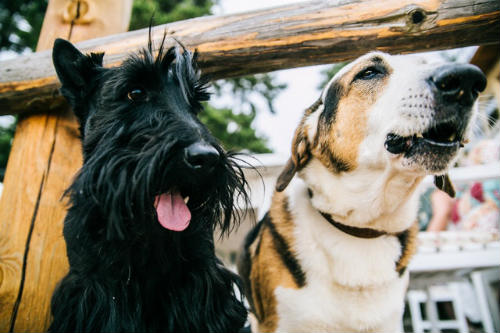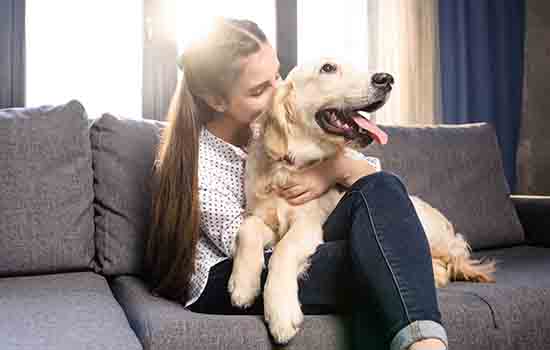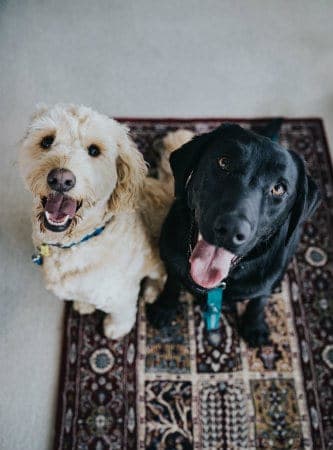For those of us who are truly fond of dogs, one just isn’t enough. Perhaps it’s that humans and dogs are both pack animals, and we instinctively crave a larger pack. However, this can be a major problem if your dogs don’t get along.
Canine aggression can be a scary thing if you aren’t prepared. On one occasion, I had to rehabilitate a pit bull who had (most likely) been used for illegal dogfighting. At first, I was unprepared for the levels of aggression that I saw.
However, that pit bull turned out to be a great success story, as he has now become an excellent pet. He still lives with me to this day, and I wouldn’t trade him for anything in the world. It just goes to show that peace, like aggression, can be taught.
With this idea in mind, let’s think about how you can train your dogs to get along better. You shouldn’t have to separate them at all times. You probably don’t want to get rid of either dog, so let’s weigh the facts and consider your options.
Understanding the Causes of Canine Aggression

A pack of dogs, whether in the wild or your home, operates under a specific set of rules. These rules will vary a little from pack to pack, but the importance of social boundaries to a dog cannot be overstated.
In general, canine aggression is caused by the transgression of one or more of these social boundaries. While dogs usually have trouble understanding human concepts, they have no problem understanding the concept of territory, for instance.
It is usually the case that males are more aggressive than females, especially when it comes to dog-on-dog aggression. This is because male dogs have a natural inclination to fight other males, both to increase their social standing and to attract mates.
If there happens to be a female around, two males are even more likely to fight. The reasons for this fact should be obvious. if that female happens to be in heat, the chances of a fight go up astronomically.
Get and Use Safety Equipment
Because we want this article to be useful for everyone, we will assume that you are dealing with some severe aggression. As for less aggressive dogs, you should still take the same precautions because animals tend to surprise us.
As such, you should make use of some simple safety equipment as you train your dogs to become friends and to refrain from tearing into one another. You will need a strong steel cage, a pair of thick leather gloves (the thickest you can find), and a muzzle for each of your dogs. For cases of mild aggression, the cage is optional.
You should also have harnesses and strong leashes for both dogs involved. This will depend on the size of the dog, but a harness is much better than a collar. When a dog goes after another dog, they tend to be pretty serious.
When they are overcome with this canine rage, they are much more likely to slip their collar. Alternately, they might also choke themselves badly as they struggle to go after the other dog. Any way you slice it, a harness is better for these situations.
The Initial Bonding Procedure

The idea is straightforward. You put muzzles on both dogs, and take them for a walk. Make sure that those muzzles are good and tight. If at all possible, you should have a friend or family member to handle one of the dogs while you walk the other.
If you are dealing with a large-breed dog, you will definitely need a second person. Bear in mind that large-breed dogs present special dangers when it comes to aggression. To the best of my knowledge, no one has ever died as a result of a chihuahua bite.
Bring the dogs to a place where neither of them has been before. I prefer to take them to a natural setting like a public park that isn’t too crowded. Try to keep them away from other dogs, as the mere sight of these other dogs could start trouble.
If the two dogs fight on the walk, the muzzles should prevent them from giving a good bite. You and your helper should each grab a dog and pull up and apart at the same time. Your timing won’t be perfect but do the best you can.
While you are out, do not feed the dogs, since that might give them something over which to fight. Like humans, dogs are less likely to fight if there is no reason for them to do so. However, giving them treats at the same time isn’t a bad idea.
When you get back home, you and the dogs must enter the home in a certain order. This is critically important for the dogs if you want them to understand what is expected of them.
First, the master (you) enters the home. The reasons for this are obvious. When you enter, leave the new dog outside and take the other dog into the house. Now, have your helper lead the new dog into the house, allowing your first dog to meet the new dog at the door.
If the first dog is willing to accept the new dog as part of the pack, they will allow the new dog to enter. For your part, you should greet the helper at the door in a friendly manner. Why? Because every dog tends to follow its masters’ lead.
The Cage Method

Now you will find out why I said you need a strong steel cage. First, let me explain what I mean when I say “steel cage.” I mean, a cage that is made entirely (not partially) of steel. It should allow visibility on all four sides.
This is a method that is mainly suited for highly aggressive dogs, or for dogs who need to get along with cats. It may not be necessary for cases of mild aggression. In any case, this method is great for cases involving an animal of unknown temperament.
Take your first dog and put them in the cage. Make sure that the dog is wearing a muzzle to prevent them from biting the cage and possibly damaging their teeth. Try to calm them as much as possible.
Now bring the other dog into the room. This dog should have a muzzle, as well. Even if the new dog doesn’t seem aggressive, it’s always good to be on the safe side. If dogs are determined enough, they can hurt each other through the bars of a cage.
Keep the new dog on a leash. Let him walk around the cage, but don’t let him get too close. You don’t want the first dog to feel that he is being provoked or taunted. I say “he” because, let’s face it, this will usually be two males if this level of caution is necessary.
This method allows the dogs to get used to one another in a way that puts neither of them at risk. As they grow more accustomed to one another, you can gradually lift the precautions. This may take multiple sessions to accomplish.
First, allow the new dog to approach the cage. If the first dog growls, stop immediately and try again later. Let the dog know that you are respecting his space. Once the dogs can be close together with no growling or baring of teeth, move on.
Next, remove the muzzles and let them interact through the cage. Keep the new dog on a leash and be prepared to pull him back at the first sign of aggression. When you feel comfortable with this, you can then use the initial bonding procedure described above.
How to Break up a Dog Fight

If, in spite of all your precautions, you still end up with a dog fight on your hands, you need to know what to do. The difficulty of breaking up such an altercation is directly determined by the seriousness of the dogs in the fight.
If this is just a little playtime scuffle that went too far, a sharp word or two from you might very well be enough to end the problem. If they are a little more serious, you may have to get a little harsher. However, this will only take you so far.
After canine aggression passes a certain point, no amount of chastisement from you will break up the fight. Don’t resort to hitting the dogs; this will only make them angrier. You have to separate them.
If you don’t have anyone to help you, and you have to break the fight up, focus your attention on the more aggressive dog. If you can get him under control, the other one will be more likely to back off. You may have to push the other one with your foot.
When I say that, I don’t mean that you should kick the dog. That would be cruel and unnecessary. Just push them back so that you can have time to separate the animals fully. You will need to move quickly to keep them from re-engaging.
Get one of the dogs behind the nearest door. The important thing is to get a physical barrier between the animals as quickly as possible.
If you cannot get the more aggressive dog to release his bite, there is a trick that can help. Take a rope and tie a slipknot at the end. Now slip that loop over the dog’s jaws. You will need to lift up on the dog’s jaw so that you can get the rope past those two large canine teeth. This is where you need those thick leather gloves.
Once you get the rope past the teeth, pull it tight. The rope should be between their jaws and pulled all the way to the back. This holds their mouth open so that they cannot bite down. You should then be able to separate the two dogs.
Conclusion
Please remember that this article is written for those who are dealing with a case of extreme aggression. However, these methods are the safest if you want to ensure that your dogs, both old and new, can learn to get along.
Once your dogs “pack up,” they will not only refrain from fighting, but they will also probably become very protective of one another. We hope that this article has been helpful to you and that you can forge a happy and well-bonded pack.

This line from the article is so very true:
“It just goes to show that peace, like aggression, can be taught.”
This is an important message to us all.
Great post.